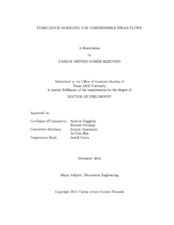| dc.description.abstract | Compressibility profoundly affects many aspects of turbulence in high-speed flows - most notably stability characteristics, anisotropy, kinetic-potential energy interchange and spectral cascade rate. Many of the features observed in compressible flows are due to the changing nature of pressure. Whereas for incompressible flows pressure merely serves to enforce incompressibility, in compressible flows pressure becomes a thermodynamic variable that introduces a strong coupling between energy, state, and momentum equations. Closure models that attempt to address compressibility effects must begin their development from sound first-principles related to the changing nature of pressure as a flow goes from incompressible to compressible regime. In this thesis, a unified framework is developed for modeling pressure-related compressibility effects by characterizing the role and action of pressure at different speed regimes. Rapid distortion theory is used to examine the physical connection between the various compressibility effects leading to model form suggestions for the pressure-strain correlation, pressure-dilatation and dissipation evolution equation. The pressure-strain correlation closure coefficients are established using fixed point analysis by requiring consistency between model and direct numerical simulation asymptotic behavior in compressible homogeneous shear flow. The closure models are employed to compute high-speed mixing-layers and boundary layers in a differential Reynolds stress modeling solver. The self-similar mixing-layer profile, increased Reynolds stress anisotropy and diminished mixing-layer growth rates with increasing relative Mach number are all well captured. High-speed boundary layer results are also adequately replicated even without the use of advanced thermal-flux models or low Reynolds number corrections.
To reduce the computational burden required for differential Reynolds stress calculations, the present compressible pressure-strain correlation model is incorporated into the algebraic modeling framework. The resulting closure is fully explicit, physically realizable, and is a function of mean flow strain rate, rotation rate, turbulent kinetic energy, dissipation rate, and gradient Mach number. The new algebraic model is validated with direct numerical simulations of homogeneous shear flow and experimental data of high-speed mixing-layers. Homogeneous shear flow calculations show that the model captures the asymptotic behavior of direct numerical simulations quite well. Calculations of plane supersonic mixing-layers are performed and comparison with experimental data shows good agreement. Therefore the algebraic model may serve as a surrogate for the more computationally expensive differential Reynolds stress model for flows that permit the weak-equilibrium simplification. | en |


